Ultimate Buyer's Guide to Akiflow vs Motion in 2024
Akiflow Vs Motion
24th Sep, 2024
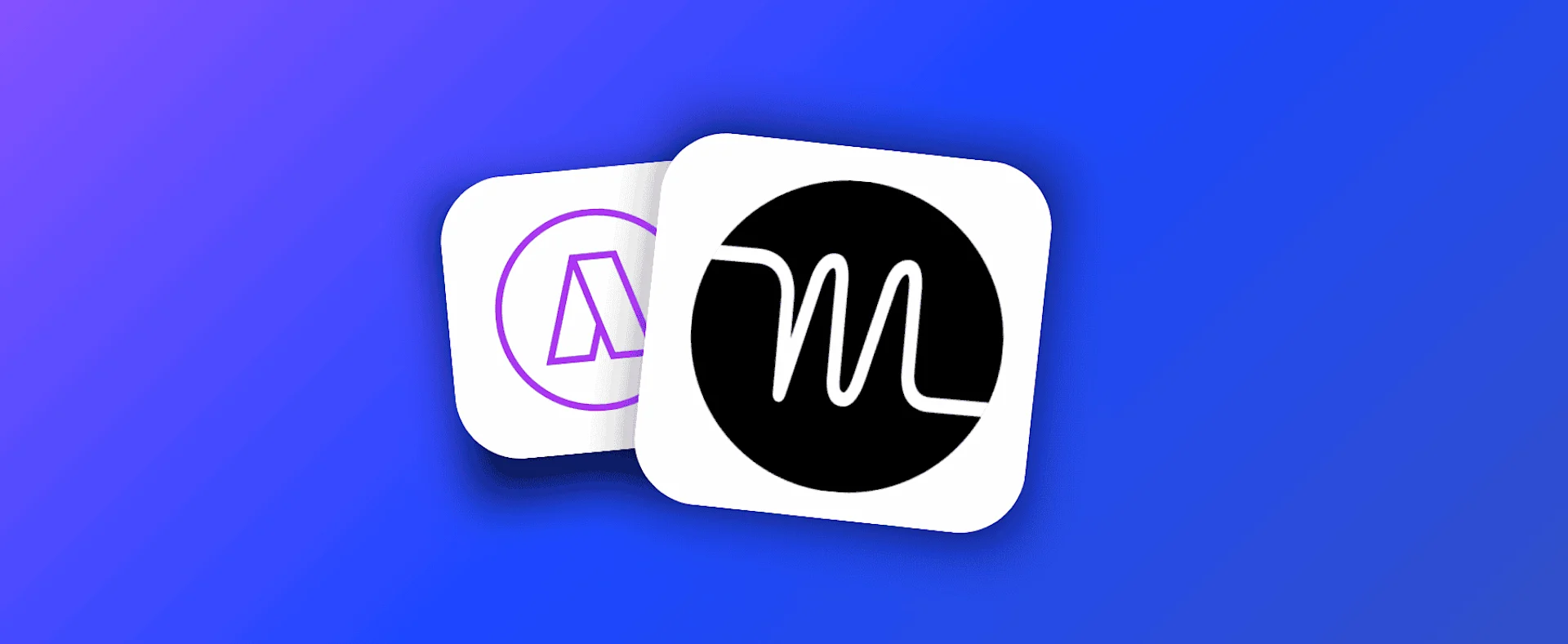
Let's explore Motion vs. Akiflow and unpack which one is best for managing tasks, calendar and daily plans. From pricing to best features, we'll help you decide.
Which should I choose, Motion or Akiflow?
So many of these daily planner apps are difficult to choose between.
They all claim to help you organize your day, even with the promise of AI.
In this breakdown, we're going to give you all the facts so that you can make an effective decision, saving you money and time. These apps aren't cheap. Whether you'll be using them for work or play, the importance of pairing with the right one will help you long term.
Both Akiflow and Motion are quality tools designed to help you establish better working schedules, manage and juggle your life, and get more done.
So, let's commence by helping you choose between Akiflow and Motion.
What we'll cover in this article...
- What do both Motion and Akiflow actually do?
- What are both their features and which are the best?
- What are the key differences between these apps for planning your day?
- What additional pros and cons do each of these have?
- Pricing breakdown to see how your money is best spent
- Final verdict on which one to go for based on our recommendations
How do we evaluate and test apps?
Tool Finder has been reviewing software for over 10+ years. Our team carefully reviews the tools, software, and apps featured here and provides valuable insights to help you decide which is best for you.
We've reviewed over 750+ apps and tools across the years and have a following on YouTube of over 415,000+ subscribers who rely on us to help them choose the perfect tool for them. These rules and regulations help us to establish the best reviews, insights & guides for you:
- We do not do paid reviews.
- We include affiliate links, but this doesn't affect our rankings.
- We recommend the best tools for the job and are trusted by you to do that.
What is Motion App?
Motion is an AI-powered to-do list app for busy professionals. Motion allows you to manage your tasks and calendar and has project management abilities for small teams. It is available on iOS, Android, macOS, Windows, and the web. Many use Motion to auto-reschedule their tasks to reduce overwhelm.
Motion connects calendar management with Google Calendar (personal and work), Outlook Calendar, and iCloud Calendar, allowing you to see what's ahead for meetings alongside your tasks in real-time.
What is Akiflow?
Akiflow is task management software combining tasks, calendars, and task consolidation by bringing tasks from apps like ClickUp, Notion, and Gmail. It is available on macOS, Windows, iOS, and Android. Akiflow is also known as a daily planner application.
Akiflow is used by freelancers, busy professionals, and those who want more than task management apps. It is well-known for managing tasks and calendars in one and comes in a similar market to apps like Motion & Sunsama.
Features Breakdown
Motion and Akiflow are advanced task management experiences battling for the top spot as the best way to manage your calendar and tasks:
Feature | Akiflow | Motion |
|---|---|---|
Tasks | Yes | Yes |
Calendar | Yes | Yes |
Task Consolidation | Yes | No |
Team | Yes | Yes |
AI | No | Yes |
Apps | iOS, Android, Desktop | iOS, Android, Desktop |
Pricing Breakdown
Let's take a look at the core differences between Akiflow and Motion in pricing:
Tools | Pricing |
|---|---|
Motion | $19 per month (annual), $34 per month |
Akiflow | $19 per month (annual), $34 per month |
How do Akiflow and Motion compare on pricing?
As you can see, the pricing is the same, making the decision even more critical.
Both charge the following monthly, so making sure you establish the right differences for you is important:
- $34 per month is a rolling rate, meaning you will pay $408 annually.
- You can save with their $19 per month option, but you must pay an upfront fee of $228.
Are Akiflow and Motion free?
Outside of the free trials they offer, which vary, you will not get a free version of Akiflow or Motion. This is an important note, both are a paid subscription model.
How much does Akiflow cost per month?
Akiflow costs $19 monthly, with a free seven-day trial if billed annually.
Plans | Pricing |
|---|---|
Solo Monthly | $34 per month |
Solo Annually | $19 per month |
Teams Monthly | $20 per month |
Teams Annual | $12 per month |
Is Akiflow free?
Akiflow comes with a 7-day free trial and no free pricing plan.
How much does Motion app cost per month?
Motion is not free and has a few pricing models; they are the following:
Plans | Pricing (approx) | What's included? |
|---|---|---|
Individual Monthly | $34 per month | All-access features |
Team Monthly | $20 per month | Collaboration with others |
Individual Annually | $19 per month | All-access features |
Team Annually | $12 per month | Collaboration with others |
Is Motion app free?
Motion is not free but offers a 14-day free trial you can get here.
Key Differences: Motion vs Akiflow
Looking at both Akiflow and Motion, there are some things that you might need to be aware of that might help you choose between them. This will help you decide more so,
Akiflow Differences to Motion
Let's first look at the killer elements of Akiflow that bring the best out:
Better Task Consolidation
Akiflow has a feature that Motion doesn't. It is called task consolidation.
This basically means that individuals who use multiple project management tools like ClickUp, task management tools like Todoist, or even email apps like Gmail can easily import emails into the platform. This idea is to reduce context switching and help individuals better manage their workload.
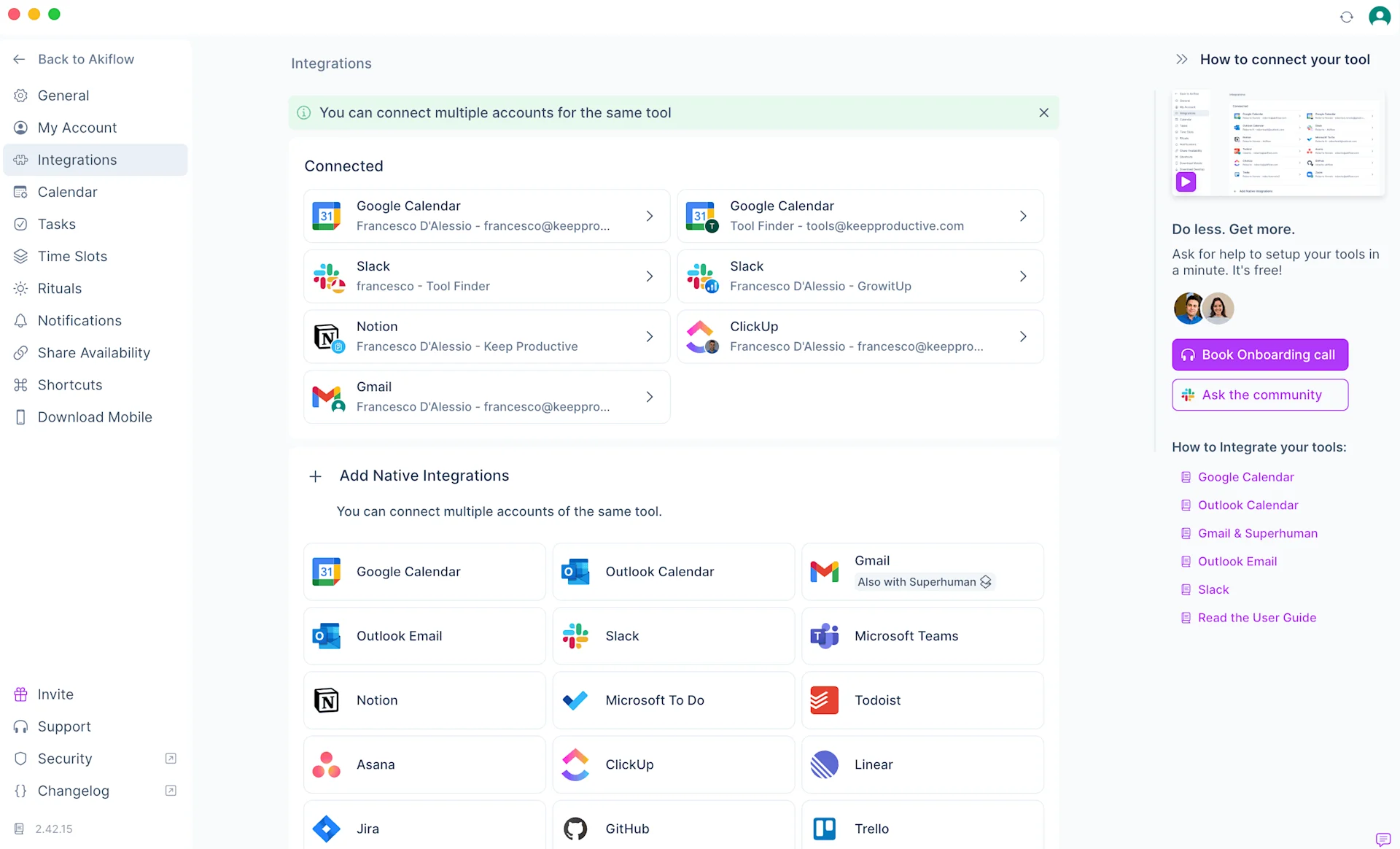
This feature is beneficial if you get invited to multiple places to work, like a ClickUp workspace for a client or a Todoist list with your partner. You can still use those tools and overlay the Akiflow dashboard on top, something Motion doesn't do.
Better Guided Planning
Akiflow brings guided planning to the table, allowing you to shut down and start your day with a feature called "rituals' that will enable you to assess the tasks you have for the day and get focused on what to do. This is done in Motion with AI but primarily relies on inputting tasks, whereas this Akiflow feature is more of a mindfulness activity.
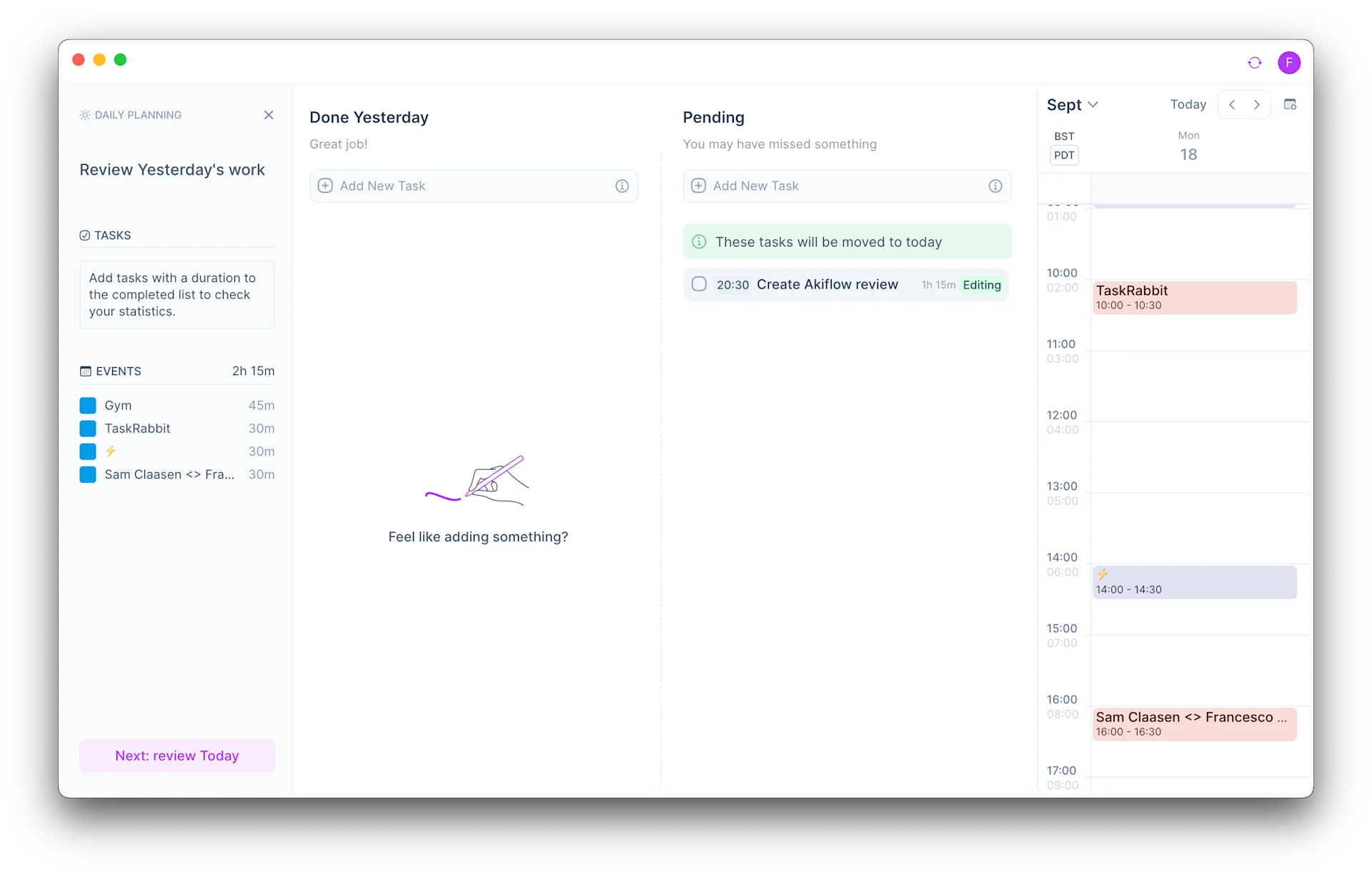
It would be great if you liked the look of apps like Sunsama but wanted something more robust regarding planning and calendar abilities or liked the look of Akiflow, as this is something Sunsama does well.
Motion Differences to Akiflow
Let's now zoom into Motion and see why you should go for it above Akiflow:
Better AI Scheduling
Motion has AI scheduling. This differs from the Akiflow feature that handles AI time and project allocation and allows you to plan tasks more effectively in your calendar using an algorithm that learns from you over time to schedule your tasks better.
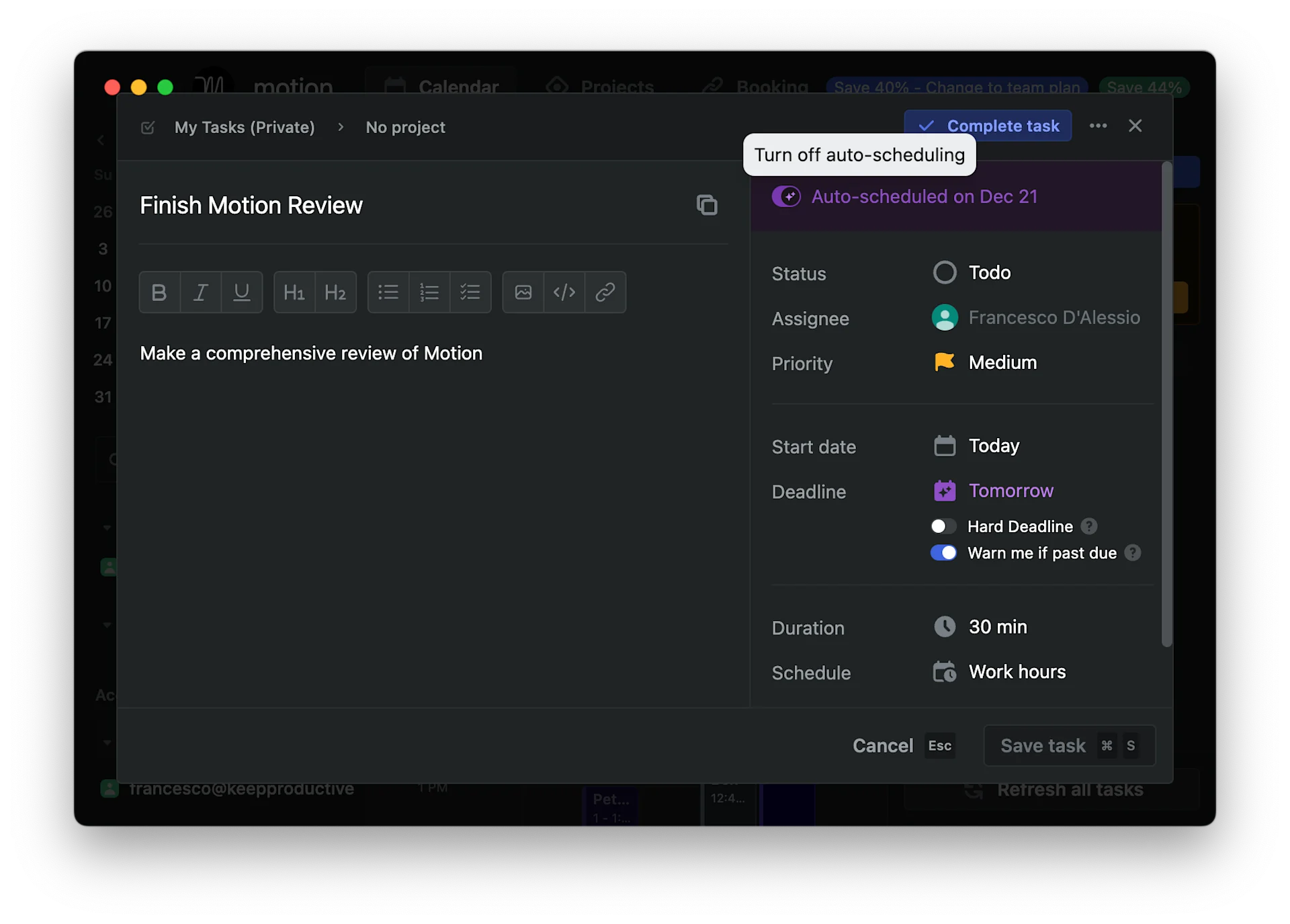
This allows you to add input to tasks, like duration, deadlines, and other attributes, then brings this into a decision model to determine the importance of tasks against calendar events and plan your schedule.
If you're tearing your hair out with productivity admin, this is a helpful feature.
Better Project Management
Sunsama has some team collaboration features that allow you to see your team members' work. Still, regarding views and real-time collaboration, Motion offers a much better way to view and collaborate with others in managing tasks.
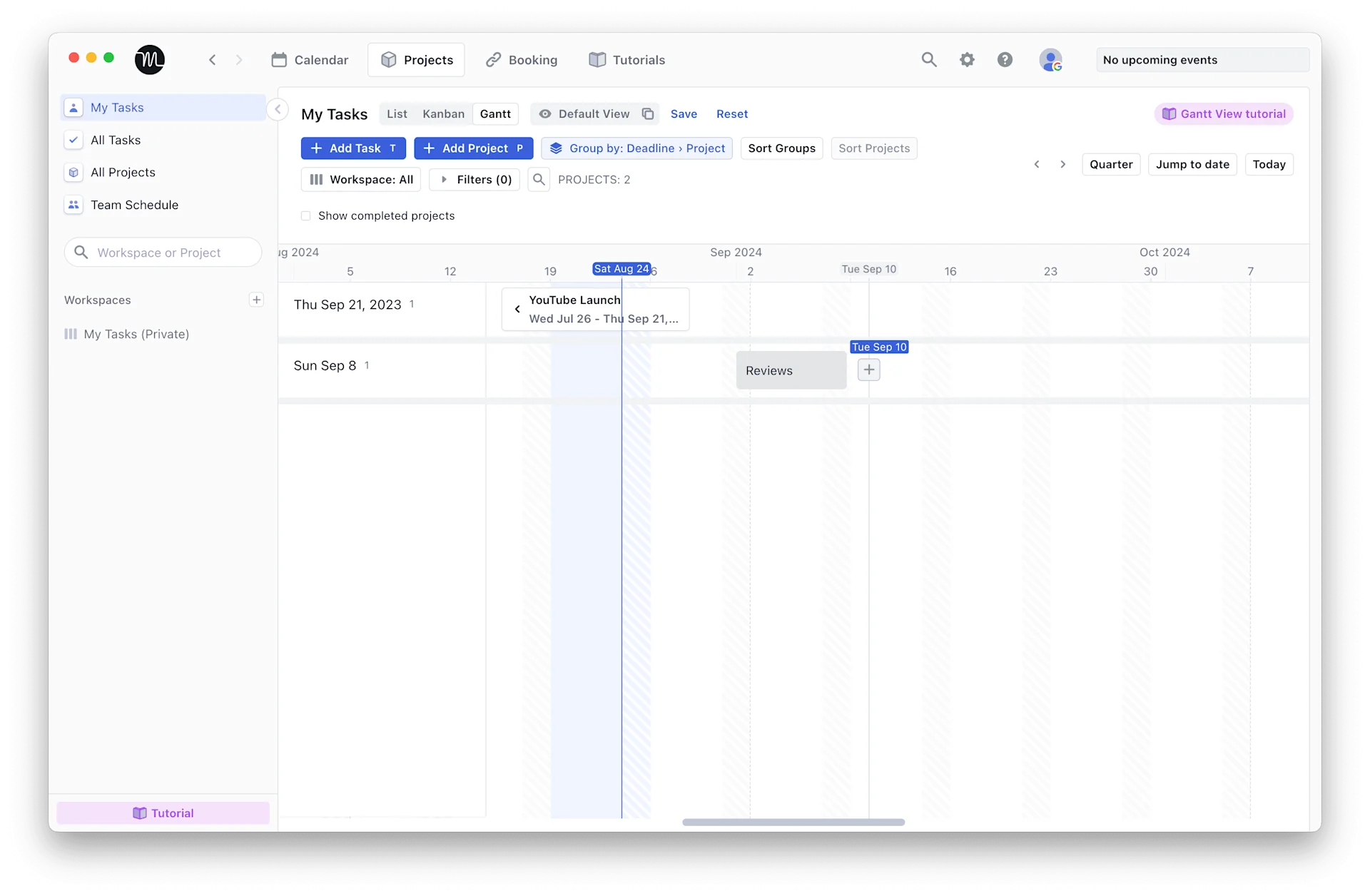
You have views like Gantt, Kanban & lists to help plan more effectively. By the sounds of it, they want to expand this for better and more inclusive project management for teams.
Pros & Cons: Motion vs Akiflow
Let's take a peek into the pros and cons of each apps and what they do well & not so well:
Akiflow | Motion | |
|---|---|---|
Pros | Task consolidation, guided planning abilities | AI scheduling, project management for small teams |
Cons | Lacks AI | Very AI focused |
Motion App Pros
- Motion is a powerful task management system with AI-planning capabilities that will help you eliminate unnecessary productivity administration from your day.
- It is easy to look at and has a minimal design on both desktop and mobile, making it easy to use for managing tasks and projects.
- More attributes to tasks like sub-tasks, status, notes, deadlines, and more are needed for the most detailed task management.
- Good project management abilities for small teams, like Kanban and Gantt, and table views for plotting projects.
Motion App Cons
- Some people might not find the value in AI planning abilities.
- The complexity of adding details to each task that helps fuel the AI planning system might be too much for some people who want to time-block and manage tasks.
- Motion is an expensive tool that many people might break their budget.
Akiflow Pros & Cons
Here's all the good and bad bits we've found about Akiflow:
Pros | Cons |
|---|---|
Easy-to-use design for beginners and intermediate users. | The mobile (iOS and Android) apps aren't as impressive as software for managing tasks on the go. |
It combines task and calendar management, making it a popular solution for time blocking. | Akiflow takes time to learn and embrace new systems and ways of doing things tailored more toward visual thinkers. |
Task consolidation allows people to bring in tasks from apps like Todoist, ClickUp, Gmail, and more to help reduce context switching. | It can be deemed as pricier compared to other task management apps on the market. |
A range of views like calendar, upcoming, and plan allows you to see your tasks from a better angle for managing what's ahead. | |
Guided planning features called Rituals make it easy to close down your day and plan tasks that were not accomplished for the day into future days. |
Best Features of Akiflow & Motion
Let's take a look at the standout features that Akiflow has above Motion:
Feature Focus
Akiflow: Task Consolidation

How does task consolidation work in Akiflow?
One of the major features in Akiflow is the ability to integrate with other applications. This means you don't have to rely solely on Akiflow for creating tasks or calendar items—you can use both systems together. Akiflow connects with a range of apps, including Google Calendar, Outlook, Gmail, Superhuman, Slack, Microsoft Teams, Notion, Microsoft To-Do, Todoist, Asana, ClickUp, Linear, Jira, GitHub, Trello, and Zoom. Additionally, you can use Zapier, a platform that allows connections with over 3,000 additional tools for managing integrations. While Zapier is a third-party service and not a native Akiflow integration, another option is IFTTT, which allows further automation between apps that Akiflow doesn’t directly support.
For example, when you integrate Google Calendar, you can select which calendars are most relevant to bring into your system. This also enables you to create Google Calendar events instantly, reducing the need to switch back and forth between Akiflow and Google Calendar. You can also import Slack messages by saving them using the “later” icon, and they will be automatically added to your Akiflow inbox.
For task management, apps like Todoist can be synced to import tasks based on specific parameters. This feature is helpful if you want to ensure that a task is properly triggered in the relevant app without overloading it with unnecessary tasks or outdated information. Similarly, with Notion, you can connect a database, specify which items are imported as tasks, and use other features like custom import and task completion properties.
This level of customization allows you to control how Akiflow integrates with other applications, ensuring that it doesn’t disrupt workflows in the connected apps or annoy collaborators by cluttering their systems with unnecessary tasks. The ability to configure each integration to your liking is valuable but does depend on the limitations of each app’s integration setup.
This feature is especially useful for busy professionals, as it reduces the need to constantly switch between multiple applications. For example, if someone uses Todoist for personal tasks, Linear for development projects at work, and Google Calendar for scheduling, Akiflow’s task management system allows them to coordinate all three in one place. While it may require separate subscriptions for each app, the benefit of centralizing everything into a dashboard streamlines the user experience.
Feature Focus
Akiflow: Rituals & Focus Mode

Does Akiflow have any work-life balance features?
Akiflow has a few features that promote healthy, sustainable work during your busy day. These come in two forms: focus mode and rituals.
Rituals allow you to shut down your day and plan the day. A system called guided planning is used in applications like Sunsama. This is an effective technique to help establish healthier habits for your mental health in these apps. The focus mode can be accessed inside each task, allowing you to zoom in, see your task details and notes, and focus on what's at hand. Perfect for those who like to mono-task.
Feature Focus
Motion: Meeting Scheduling
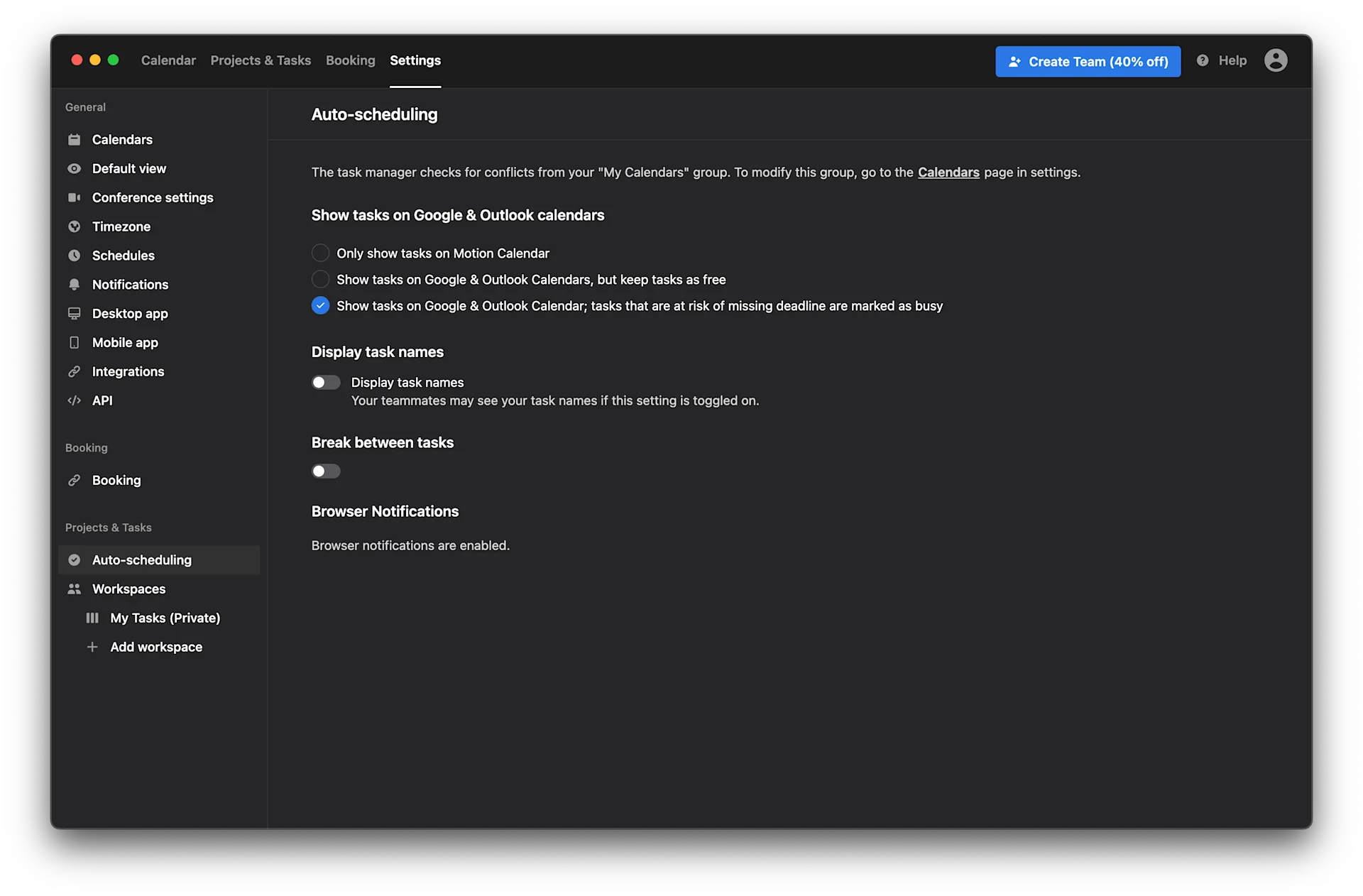
How does meeting scheduling work in Motion?
Meeting scheduling and booking pages are great in Motion.
You can manage tasks and use the booking scheduler for meetings, which is great for bypassing tools like Calendly and other such calendar meeting scheduling apps.
We’d highly recommend this if you want to book meetings with AI because when you send out that link, you can set plenty of defining parameters like “don’t book a meeting 30 minutes together” or “within the two days of the current day” — and this playing in with the AI means you can really customize what and when meetings land.
Feature Focus
Motion's AI Task Management
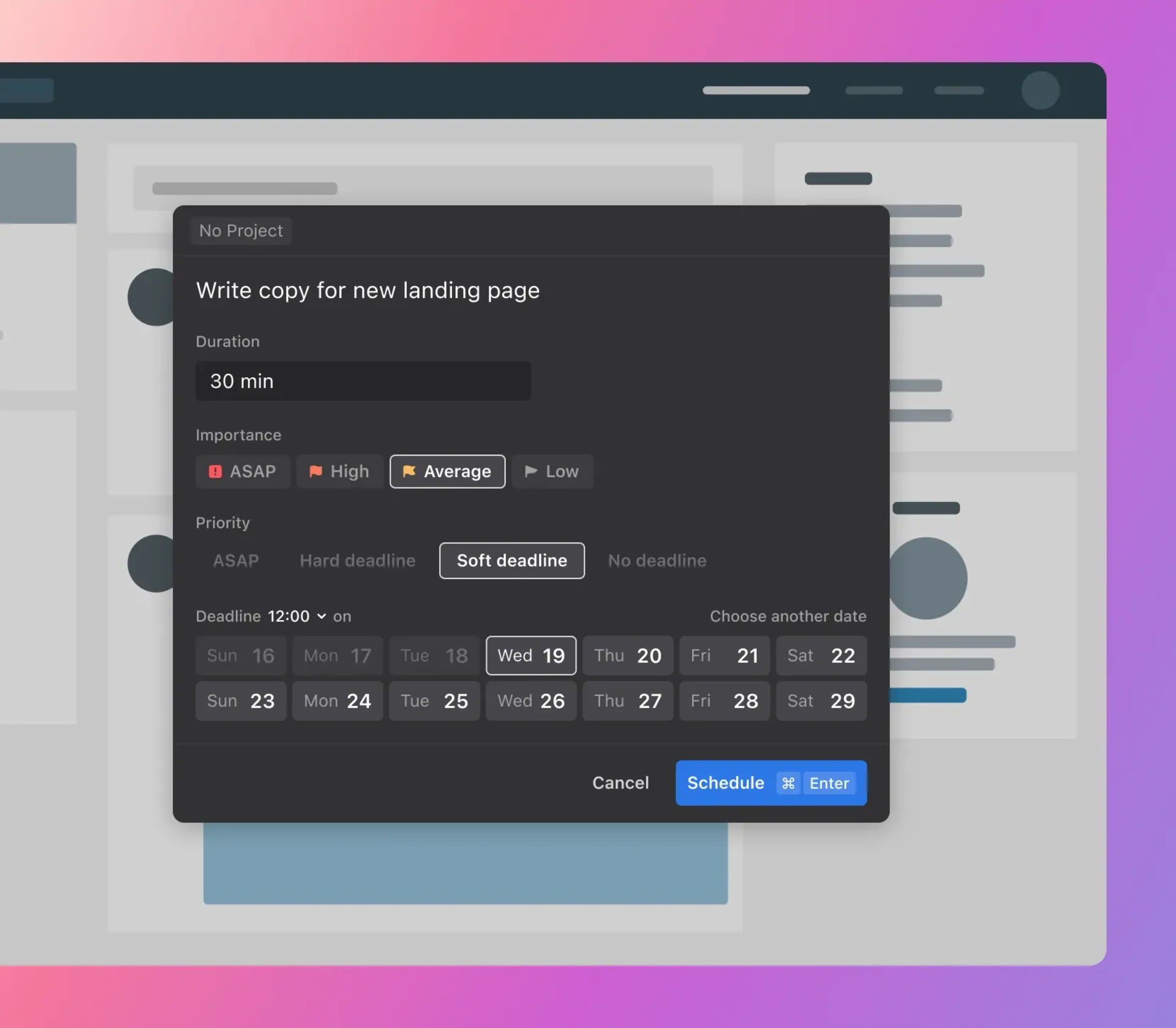
How does AI task management work in Motion?
The masterpiece feature in Motion is AI.
The magic of Motion is the AI functionality, which allows you to add a task and for the AI to judge how important that truly is. The more tasks, meetings, and items you add, the better the AI validates the importance of tasks. This is a massive pro for those struggling with prioritization and needing assistance valuing the importance of functions using simple task input task management.
Compared to Akiflow, which doesn't have any form of AI right now, Motion separates itself well in the sense that it feels more premium when it comes to better planning and a less manual experience—this is why it is more common with professionals who handle tasks and want to be more hands-off with their task management.
Our Ratings
Our formal ratings give Motion and Akiflow very similar scoring, with Motion pipping Akiflow by a few points; let’s unpack that and see why we believe Motion to be more suitable in areas as a package for planning your week and task list alongside your calendar.
These five critical aspects of the tool are how we rate and review our tools.
Design (Winner: Akiflow)
Both Motion and Akiflow have good designers behind them.
Although we rated Akiflow higher for design, the experience from the calendar to the upcoming view is fantastic and presents a clean and simple look.
Features like Rituals (like Sunsama) show this well. We think Akiflow is better if you're more keen on design and what the application looks like. Although Motion isn't exactly ugly, it has a clean look, too. We just rate Akiflow higher. Akiflow wins our design award here.
Features (Winner: Motion)
Power features belong to Motion here.
Motion is much more tailored to a growing team, so I’d say with the AI, task input, calendar blocking, and combination of meeting scheduler with AI functions—it offers collectively more. Akiflow is a very, very close second with their task consolidation, objectives, rituals, and more. There are more opportunities in Motion to expand the tool beyond just solo use.
Performance (Winner: Motion)
This was too close. Speed isn’t an issue with both of these. From our tests, Akiflow and Motion are very marginal, but Motion’s performance in-app and loading seems snappier than Akiflow's. Again, they are close. We found Motion to be snappier and faster, although on startup, Akiflow always won.
Practicality (Winner: Akiflow)
Availability: Only recently have Motion and Akiflow been outside of the desktop world. So this one is too close to call. Akiflow wins it for having the tools for longer.
Value for Money (Winner: Akiflow)
Bang for your buck; we think the most cost-effective is Akiflow.
Akiflow is less expensive than Motion yearly, so Akiflow takes the mark here. As for the value you get from Akiflow, too, as your base for dashboards, it is a good value if you go with it yearly. It is less so on monthly pricing, like all these software tools today.
Motion or Akiflow: Our Verdict
Let’s keep this super simple and focus on the core differences — which one is better?
- Motion is much better if you need more help with meetings, task prioritization, and calendar management. The AI in Motion works well to help you define what is essential.
- Akiflow is much better if you want your task app to be the dashboard app for all your other activities, and you’re not sold on any AI elements yet.
In our judgment, there’s a key difference between AI (Motion) and task consolidation (Akiflow)—we believe it is whatever tempts you the most.
Motion is better for busy professionals who want their task management to judge and better allocate time for them.
Recommended Reads
Similar to your current reading interests:
Oops, undefined is still in development...
Weekly Roundup: Explore People's Productivity Tools
Become a reader to our newsletter exploring what productivity apps people use on a daily basis to get things done